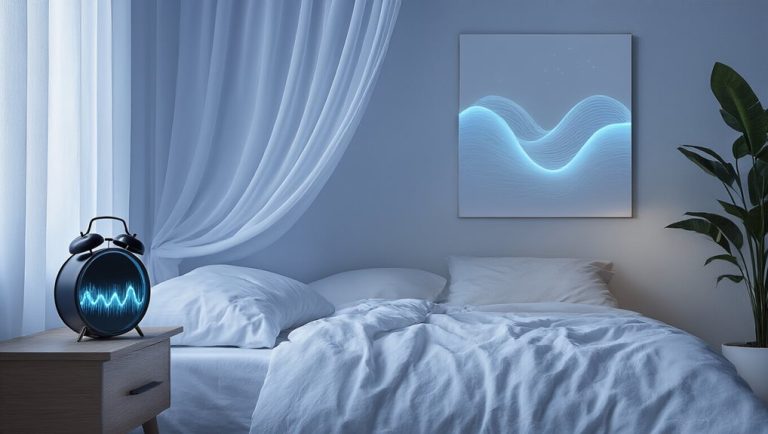Clinical studies show that binaural beats can effectively reduce tinnitus symptoms by promoting brainwave synchronization, especially within delta, alpha, and theta frequencies. These interventions often outperform standard maskers, offering improvements in quality of life, stress, and depression. Although current research highlights promising results, limitations like small sample sizes and variable protocols exist. Continuing the exploration reveals a deeper understanding of how targeted neural entrainment may be integrated into future tinnitus management strategies.
Overview of Tinnitus and Its Impact on Daily Life

🎧 Try a Free Subliminal
No signup or login required — experience our Millionaire Mind Subliminal instantly.
Tinnitus is the perception of sound without an external source, often described like ringing, buzzing, clicking, or humming, and it can vary in pitch and intensity. Tinnitus symptoms range from intermittent to continuous and may be perceived in one ear, both ears, or the head. It is often associated with hearing loss and difficulty in noisy environments, leading to interference with concentration, anxiety, and depression. Persistent tinnitus can greatly impair daily functioning, affecting sleep, concentration, and communication. The psychological effects are considerable; many individuals develop anxiety, depression, or cognitive difficulties, with severity often correlating more with psychological factors than sound loudness. About 20% of affected individuals seek treatment due to distress.
Chronic tinnitus can lead to diminished quality of life, social withdrawal, and increased emotional burden, emphasizing the importance of understanding its impact on general wellbeing and functional capacity. Recent studies suggest that brainwave entrainment techniques may offer promising relief by promoting relaxation and reducing anxiety symptoms associated with tinnitus. Subliminal audios targeting the subconscious mind have been shown to engage neural pathways linked to emotion and memory, potentially aiding in the management of tinnitus-related stress.
How Binaural Beats Work: The Science Behind the Technique
You can understand binaural beats in the capacity of a method that induces brainwave synchronization by presenting different frequencies to each ear, prompting the brain to perceive a third tone. This process relies on the frequency-following response, where neural activity entrains to the beat frequency, potentially altering mental states and enhancing focus and concentration.
Neural processing involves key structures like the superior olivary complex, which coordinates bilateral input and influences general brainwave activity. Early responses to binaural beats have been recorded in the superior olivary complex of the brainstem, and responses are also observed in the inferior colliculus, phase-locked to binaural-beat frequency. For optimal experience, stereo headphones are required to deliver the distinct frequencies separately to each ear.
Brainwave Synchronization Process
The brainwave synchronization process underpinning binaural beats involves the entrainment of neural oscillations to external auditory stimuli.
When you listen to binaural beats, your brain’s neural oscillations—categorized into brainwave types like delta, theta, alpha, beta, and gamma—adjust their frequency to match the perceived beat.
This synchronization promotes hemispheric cooperation and improves phase synchronization across neural networks. Consequently, you may experience specific cognitive effects, including enhanced attention, memory, and mental flexibility.
The entrainment mechanism facilitates neural plasticity by aligning brainwave activity with the stimulus frequency, supporting different mental states.
Understanding this process clarifies how binaural beats can influence cognitive functions and contribute to conditions like tinnitus through targeted brainwave modulation.
Frequency Following Response
The frequency-following response (FFR) is a neurophysiological process where the brain’s electrical activity aligns with the frequency of an auditory stimulus, including binaural beats. This phenomenon results from frequency modulation within the auditory perception system, where neural circuits synchronize with the beat frequency. When exposed to binaural beats, the superior olivary complex in the brainstem facilitates neural entrainment, leading to measurable changes in EEG amplitudes at the specific frequency.
This synchronization reflects an active modulation of brainwave activity, influencing cognitive and emotional states. The FFR can be observed using EEG, which captures the brain’s electrical responses to auditory stimuli. FFR demonstrates the brain’s capacity for subcortical and cortical entrainment, making it a key mechanism behind binaural beats’ potential therapeutic effects, including tinnitus relief through targeted modulation of auditory perception and neural oscillations.
Methodology of Recent Clinical Studies on Binaural Beats and Tinnitus

Recent clinical studies investigating binaural beats for tinnitus relief employ rigorous methodologies designed to evaluate their efficacy systematically.
The study design typically involves randomized controlled trials, with participants allocated to binaural beats or comparator groups, such as standard tinnitus maskers or no sound stimuli. These designs help to amplify concentration on the specific effects of binaural beats versus other auditory interventions. The utilization of brainwave entrainment techniques is often integrated to target specific neural frequencies associated with auditory processing.
Sample selection emphasizes strict inclusion criteria, often requiring individuals with chronic tinnitus lasting over six months, minimal hearing loss, and no significant otological, neurological, or psychiatric conditions. Researchers screen participants for cognitive function, depression, and anxiety using standardized scales like MMSE and HADS to control confounding factors.
Some studies restrict age brackets and right-handedness to reduce variability. These methodological choices guarantee the reliability and reproducibility of findings, facilitating accurate assessment of binaural beats’ therapeutic potential.
In addition, researchers often utilize blinding procedures(to minimize bias) and standardized protocols across sessions to ensure consistency in treatment delivery.
🎧 Start Your Audio Journey
Relax, recharge, and reprogram your mind with our Free Millionaire Mind Subliminal. No signup needed.
Key Findings From the Latest Research
Emerging evidence from recent clinical research demonstrates that binaural effects can considerably reduce tinnitus symptoms through acoustic therapy.
Studies show that targeted binaural beats, especially in delta, alpha, and theta frequencies, induce brainwave entrainment that correlates with symptom alleviation. Remarkably, these effects often surpass outcomes from standard tinnitus maskers, highlighting binaural beats’ potential as an effective intervention. This entrainment also promotes relaxation and stress reduction, which can contribute to symptom relief.
Participants report not only symptom relief but also improvements in quality of life, including reduced stress and depression.
While the mechanisms may involve both brainwave entrainment and sound therapy effects, further research is needed to clarify long-term efficacy and ideal frequency combinations.
In general, these findings support binaural beats as a promising component of extensive tinnitus management strategies.
Additionally, stimulating gamma brain wave production through sound therapy has been shown to enhance cognitive function, which may further benefit individuals coping with tinnitus.
Comparing Binaural Beats to Traditional Tinnitus Treatments

Compared to traditional tinnitus treatments, binaural beats demonstrate comparable or superior effectiveness in symptom reduction over extended periods, like three months. Their ability to enhance focus and productivity may also contribute to improved coping strategies for tinnitus sufferers.
Treatment comparison studies reveal that binaural effectiveness results in significant reductions in THI and VAS scores, often matching or exceeding outcomes from standard sound therapies and maskers. Different frequencies—delta, theta, and alpha—are similarly effective, suggesting benefits aren’t frequency-specific.
Furthermore, binaural beats improve quality of life by alleviating psychological distress and enhancing physical health, comparable to traditional approaches. Their potential for integration into clinical practice as a complementary therapy is supported by these findings.
However, further randomized controlled trials are necessary to validate long-term benefits and clarify mechanisms, ensuring binaural effectiveness is established as a reliable treatment option.
These findings align with the role of neuroplasticity in facilitating positive changes in brain function through repeated auditory stimulation.
Potential Mechanisms of Action in Tinnitus Relief
Binaural beats may alleviate tinnitus symptoms through several interconnected mechanisms rooted in neural activity modulation.
By inducing brainwave entrainment, binaural beats shift neural pathways toward specific frequencies, influencing auditory perception and reducing tinnitus perception. This sound therapy can improve neural plasticity, promoting adaptive changes in auditory and non-auditory brain regions. Recent research highlights that gamma frequency binaural beats can bolster attention and cognitive processing, which may further support auditory rehabilitation.
The frequency following response enables the brain to mimic external sound frequencies, facilitating balanced neural activity and decreasing abnormal neural firing linked to tinnitus.
Moreover, binaural beats can modulate neural activity to diminish stress and anxiety, which are known to exacerbate tinnitus.
Studies have consistently shown that sound therapy can decrease cortisol levels, heart rate, and blood pressure, further contributing to tinnitus relief.
Limitations and Considerations of Current Studies

Many studies investigating binaural beats for tinnitus relief face significant limitations that impact the robustness and applicability of their findings.
Small sample sizes reduce the statistical power, and recruitment biases narrow participant diversity, limiting generalizability. Methodological concerns, such as inconsistent measurement tools like THI and VAS, hinder cross-study comparison.
Limited participant diversity and inconsistent measurement tools hinder reliable comparisons across binaural beat tinnitus studies.
Follow-up issues prevent assessment of sustained effects, while short durations restrict understanding of long-term benefits. Conflicting findings arise from heterogeneous protocols, variable binaural beat frequencies, and lack of objective physiological measures.
These limitations challenge clinical integration and undermine confidence in efficacy. Moreover, few studies incorporate thorough psychological assessments, which are fundamental for understanding individual variability and treatment response.
Addressing these issues is imperative for advancing evidence-based tinnitus interventions.
Future Directions and Practical Implications for Patients
Future research should prioritize long-term studies to determine the sustained benefits of binaural beats for tinnitus relief. Understanding how different brainwave frequencies impact tinnitus symptoms over time can significantly advance treatment approaches.
Developing personalized protocols tailored to individual tinnitus characteristics can improve treatment efficacy, while integrating these therapies into daily routines may improve adherence and outcomes. Creating a supportive environment and incorporating relaxation techniques like deep breathing can enhance the effectiveness of these protocols.
Addressing these areas will provide clearer guidance for clinical practice and empower you to manage tinnitus more effectively.
Additionally, exploring the neural mechanisms behind brainwave entrainment can further enhance the development of targeted binaural beats therapies.
Long-term Effectiveness Studies
Emerging evidence indicates that extended binaural beats (BB) therapy can produce sustained reductions in tinnitus severity and improvements in psychological well-being, with benefits persisting up to three months post-treatment.
Long-term benefits suggest neuroplastic changes that support ongoing symptom management. To optimize these benefits, therapy adherence is crucial, requiring consistent daily sessions.
Key considerations include:
- Maintaining regular practice to reinforce neural adaptations
- Monitoring symptom progression over months for lasting relief
- Incorporating pleasant soundscapes to improve comfort and engagement
These factors influence the durability of therapeutic gains, emphasizing the importance of sustained application.
Continued research is needed to determine ideal maintenance protocols, but current findings indicate BB therapy offers promising long-term management options for tinnitus sufferers committed to consistent use.
Personalized Therapy Development
Advances in personalized neuromodulation and sound therapy are shaping the future of tinnitus management by enabling treatments tailored to individual auditory profiles.
Therapeutic advancements focus on creating personalized approaches that target specific neural pathways and tinnitus characteristics. For example, Stanford’s development of adaptive Acoustic Coordinated Reset stimuli adjusts dynamically to changes in tinnitus frequency, enhancing treatment efficacy.
Likewise, multimodal therapies combine pitch-matched sound with electromagnetic stimulation to desensitize auditory pathways.
Digital solutions like Frequency Customized Relieving Sound (DFCRS) utilize smartphone apps to deliver individualized therapy based on patient-specific tinnitus profiles.
These personalized approaches improve engagement, optimize outcomes, and pave the way for more precise, effective tinnitus management strategies, ultimately increasing the likelihood of symptom reduction or elimination.
Integration Into Daily Routines
Integrating binaural beats into daily routines offers a practical, non-invasive approach to tinnitus management that can be maintained over extended periods.
Consistent use, typically around one hour per day with headphones, improves patient engagement and therapy adherence. Portable devices and smartphone apps facilitate self-management, allowing you to incorporate sessions seamlessly into your daily activities.
Proper education on volume and duration maximizes benefits while minimizing discomfort. Regular routine adherence correlates with significant reductions in tinnitus severity, in relation to THI and VAS scores.
To foster emotional well-being, consider pairing BB sessions with stress reduction techniques or relaxing activities. Establishing a predictable schedule, like before sleep or during breaks, supports sustained engagement and improves general quality of life.
Common Questions
Can Binaural Beats Completely Eliminate Tinnitus Symptoms?
While tinnitus management benefits from sound therapy, binaural beats alone don’t fully eliminate symptoms. Evidence shows they reduce distress and improve quality of life but serve better in conjunction with rather than definitive cures for tinnitus.
Are There Any Risks or Side Effects From Using Binaural Beats?
You should know that binaural beats generally pose minimal potential risks or side effects, with no lasting harm reported. However, individual responses vary, and some may experience cognitive or auditory effects, so monitor your reactions during use.
How Long Does It Typically Take to Notice Improvements?
While tinnitus duration varies, most individuals notice improvement within weeks to a month of consistent binaural beats therapy, aligning with typical improvement timelines. Individual response differences highlight that some may experience faster or slower symptom relief.
Are Binaural Beats Effective for All Tinnitus Types?
You should know that binaural beats are primarily effective for tinnitus types in individuals with normal hearing sensitivity, with binaural variations at delta, theta, and alpha frequencies showing similar benefits, though efficacy across diverse tinnitus types requires further research.
What Are the Best Practices for Incorporating Binaural Beats Into Daily Routines?
While routines vary, integrating binaural beats into daily relaxation techniques—preferably during calm, focused moments—can improve tinnitus relief; consistency and ideal timing support brainwave entrainment, but avoid overuse until safety data confirms long-term effects.
Final Thoughts
While current studies suggest binaural beats may offer tinnitus relief, results remain mixed due to limitations in research design. As the saying goes, “Rome wasn’t built in a day,” so ongoing investigation is crucial. If you’re considering this approach, consult with a healthcare professional to confirm it’s appropriate for your specific condition. Evidence supports exploring binaural beats as a complementary option, but don’t rely solely on it—integrate with established treatments for best results.




